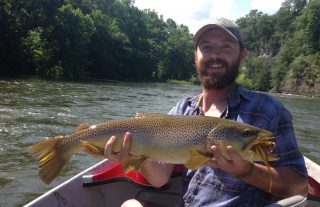
Obviously your rain dance didn’t work! October and November in Western North Carolina were abnormally dry and, as a result, our rivers are dry and our forests are on fire. The streamer bite that we all anticipated so highly has not been what it could have been with more water and we’re all a little nervous about what this drought could bring.
Luckily, we always have midge fishing. “Midge” is really a blanket term for an extremely wide variety of small aquatic insects that populate most trout streams year-round. Although small, these insects are plentiful and make up a large portion of a trout’s diet. Regardless of the water level or temperatures, midges are a card that a successful fly fisherman always keeps in his hand.
Like most other types of flies, midge patterns can be separated into three categories: nymphs, emergers and dries. A well-stocked midge box will have all three. The important thing for all midge patterns, however, is size. Midges are typically size 18 or smaller, with the most productive patterns usually falling in the 22-26 range. If you are tying your own, use small thread and keep the flies slim and simple. Whether you tie or buy, though, be sure to stock your boxes with a variety of color combinations. Often, subtle changes in rib or bead color can be the factor that turns your day around.
Popular midge nymph patterns include the trusty zebra midge, Charlie Craven’s jujubee midge, and small brassies. Midge nymphs are a great fly to drop behind another, larger nymph, such as a stonefly, as part of a double nymph rig. Obviously, weight your rig and change your depth according to water conditions.
Seeing a trout rise to a tiny dry fly has a unique appeal, unmatched by any other technique. Midge emergers come in handy as a midge hatch begins to crank up. Although, many popular patterns like Brook’s sprout emerger and the smokejumper midge have brightly colored posts, they are still difficult to see on the water. Fishing one of these small emergers behind another, larger dry fly will help you to locate it on the water. Midge dries may be fished the same way as emergers: dropped behind another, larger dry fly. Patterns such as the Griffith’s gnat imitate a cluster of extremely small midges congregated on the water’s surface. Snowshoe hare and CDC midge dries in very small sizes can imitate individual adult midges.
As we transition from fall into winter, water temperatures will continue to drop. These colder water temperatures force the trout out of the riffles and pocket water they clung to for oxygen in the summer and into the slower, deeper pools where they can bask in the sunlight on a clear day, or sink to the bottom for warmer water on the coldest of days. If you see fish rising, but you are unable to tell what they are rising to, a midge dry is a good place to start. A midge dry dropped in the riseform of a feeding fish may tempt that fish to sip. If fishing subsurface, weight your rig enough to reach the bottom and drop the midge nymph off your point fly. Just be careful on the hookset. Many midge patterns are so small that 6x is required to thread the eye of the hook.
Continue to pray to the river gods, dance your rain dances, make offerings – do whatever magic you must to bring a few raindrops to our rivers. Until then, fish small and light and hold off on that extra cup of coffee. Size 26s are tough to tie on with a case of the shakes.
Bryce Butner, a graduate of the University of North Carolina at Chapel Hill, is a part-time guide for Southern Drifters Outfitters in Burnsville, NC. He spends his days teaching high school and his afternoons, summers and weekends in the WNC high country or on a Tennessee tailwater. His flies look decent, but he has great hatch juju.